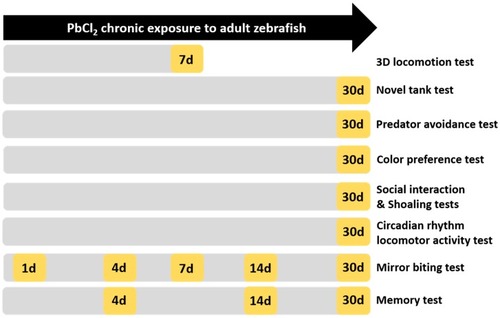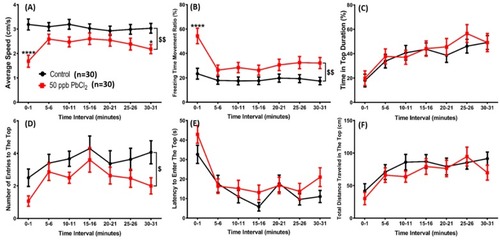- Title
-
Chronic Exposure to Low Concentration Lead Chloride-Induced Anxiety and Loss of Aggression and Memory in Zebrafish
- Authors
- Bui Thi, N.H., Nguyen Thi, N.A., Audira, G., Siregar, P., Liang, S.T., Huang, J.C., Hsiao, C.D.
- Source
- Full text @ Int. J. Mol. Sci.
|
Schematic diagram of the evaluation of the neurobehavioral toxicity of PbCl2 in zebrafish. Yellow indicates the time points (day) for conducting behavioral assays. After 30 days, all fish were sacrificed and the biochemical assays were performed. |
|
Comparison of three-dimensional (3D) behavior among seven-day PbCl2-exposed groups and a control group. ( |
|
Comparison of behavioral endpoints in the novel tank exploration test among 30-day 50 ppb PbCl2-exposed groups and a control group. Six parameters were evaluated: ( |
|
Evaluation of aggressiveness and fear by mirror-biting and predator avoidance tests between the control and 50 ppb PbCl2-treated fish. After PbCl2 exposure (red line), the mirror biting behavior was chronologically monitored and the data were presented as ( |
|
Comparison of the conspecific social interaction and shoaling between control and 50 ppb PbCl2-treated fish. After PbCl2 exposure, the conspecific social interaction was monitored and the data are presented as ( |
|
Evaluation of the circadian rhythm locomotor activity for control and chronic PbCl2-treated fish (50 ppb, red). ( |
|
Passive avoidance task to test the short-term memory of fish treated with different exposure durations in 50 ppb of PbCl2. ( |
|
Comparison of the color preference between control and PbCl2-exposed fish (50 ppb for 30 days). The combinations of four colors are ( |
|
Biochemical parameters of the control and 50 ppb PbCl2-exposed fish. The levels of biomarkers, including ( |
|
Schematic representation of the biochemical and behavioral signatures detected in chronic and low dose PbCl2-exposed zebrafish. The signatures of biochemical (blue) and behavioral (pink) tests are summarized (↑: upregulated, ↓: down regulated). |










